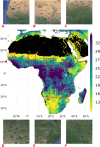Characterizing the Response of Vegetation Cover to Water Limitation in Africa Using Geostationary Satellites
- PMID: 35865621
- PMCID: PMC9286687
- DOI: 10.1029/2021MS002730
Characterizing the Response of Vegetation Cover to Water Limitation in Africa Using Geostationary Satellites
Abstract
Hydrological interactions between vegetation, soil, and topography are complex, and heterogeneous in semi-arid landscapes. This along with data scarcity poses challenges for large-scale modeling of vegetation-water interactions. Here, we exploit metrics derived from daily Meteosat data over Africa at ca. 5 km spatial resolution for ecohydrological analysis. Their spatial patterns are based on Fractional Vegetation Cover (FVC) time series and emphasize limiting conditions of the seasonal wet to dry transition: the minimum and maximum FVC of temporal record, the FVC decay rate and the FVC integral over the decay period. We investigate the relevance of these metrics for large scale ecohydrological studies by assessing their co-variation with soil moisture, and with topographic, soil, and vegetation factors. Consistent with our initial hypothesis, FVC minimum and maximum increase with soil moisture, while the FVC integral and decay rate peak at intermediate soil moisture. We find evidence for the relevance of topographic moisture variations in arid regions, which, counter-intuitively, is detectable in the maximum but not in the minimum FVC. We find no clear evidence for wide-spread occurrence of the "inverse texture effect" on FVC. The FVC integral over the decay period correlates with independent data sets of plant water storage capacity or rooting depth while correlations increase with aridity. In arid regions, the FVC decay rate decreases with canopy height and tree cover fraction as expected for ecosystems with a more conservative water-use strategy. Thus, our observation-based products have large potential for better understanding complex vegetation-water interactions from regional to continental scales.
Keywords: Africa; ecohydrology; fractional vegetation cover; geostationary; water limitation.
© 2022 The Authors. Journal of Advances in Modeling Earth Systems published by Wiley Periodicals LLC on behalf of American Geophysical Union.
Figures

















Similar articles
-
Observation-based assessment of secondary water effects on seasonal vegetation decay across Africa.Front Big Data. 2022 Sep 9;5:967477. doi: 10.3389/fdata.2022.967477. eCollection 2022. Front Big Data. 2022. PMID: 36156935 Free PMC article.
-
Hybrid inversion of radiative transfer models based on high spatial resolution satellite reflectance data improves fractional vegetation cover retrieval in heterogeneous ecological systems after fire.Remote Sens Environ. 2021 Jan 22;255:112304. doi: 10.1016/j.rse.2021.112304. eCollection 2021 Mar 15. Remote Sens Environ. 2021. PMID: 36081599 Free PMC article.
-
A novel ecohydrological model by capturing variations in climate change and vegetation coverage in a semi-arid region of China.Environ Res. 2022 Aug;211:113085. doi: 10.1016/j.envres.2022.113085. Epub 2022 Mar 18. Environ Res. 2022. PMID: 35307372
-
Spatiotemporal evolution and driving factors analysis of fractional vegetation coverage in the arid region of northwest China.Sci Total Environ. 2024 Dec 1;954:176271. doi: 10.1016/j.scitotenv.2024.176271. Epub 2024 Sep 13. Sci Total Environ. 2024. PMID: 39278503
-
Water pulses and biogeochemical cycles in arid and semiarid ecosystems.Oecologia. 2004 Oct;141(2):221-35. doi: 10.1007/s00442-004-1519-1. Epub 2004 Feb 24. Oecologia. 2004. PMID: 14986096 Review.
Cited by
-
Observation-based assessment of secondary water effects on seasonal vegetation decay across Africa.Front Big Data. 2022 Sep 9;5:967477. doi: 10.3389/fdata.2022.967477. eCollection 2022. Front Big Data. 2022. PMID: 36156935 Free PMC article.
References
-
- Adole, T. , Dash, J. , & Atkinson, P. M. (2016). A systematic review of vegetation phenology in Africa. Ecological Informatics, 34, 117–128. 10.1016/j.ecoinf.2016.05.004 - DOI
-
- Akasheh, O. Z. , Neale, C. M. , & Jayanthi, H. (2008). Detailed mapping of riparian vegetation in the middle Rio Grande River using high resolution multi‐spectral airborne remote sensing. Journal of Arid Environments, 72(9), 1734–1744. 10.1016/j.jaridenv.2008.03.014 - DOI
Associated data
LinkOut - more resources
Full Text Sources
